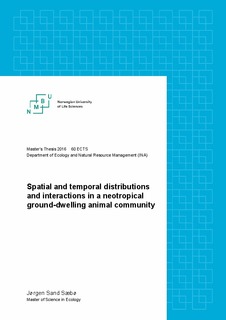| dc.contributor.advisor | Haugaasen, Torbjørn | |
| dc.contributor.advisor | Bischof, Richard | |
| dc.contributor.author | Sand Sæbø, Jørgen | |
| dc.coverage.spatial | Itamarati, Amazonas, Brazil | nb_NO |
| dc.date.accessioned | 2017-03-07T13:12:18Z | |
| dc.date.available | 2017-03-07T13:12:18Z | |
| dc.date.issued | 2016 | |
| dc.identifier.uri | http://hdl.handle.net/11250/2433166 | |
| dc.description.abstract | Distribution in time and space are central parts of a species’ niche, and linking these to environmental and anthropogenic factors are common objectives in ecological research. However, the observed distributions are inextricably linked to the complex array of interactions among members of a community. Disentangling these interactions and their effects on species distributions is a challenging task, but may improve our understanding of community structure and forecasting of distribution changes. In this thesis, I explored the spatial and temporal distribution of large ground-dwelling vertebrates in a Brazilian rainforest using a collection of camera trap images, using occupancy models and kernel density analysis. Pair-wise co-occupancy models and density overlap were applied to explore interactions among the species. The results indicated that the effect of hunting by local villagers on the spatial distributions of the observed species were limited. However, the black agouti (Dasyprocta fuliginosa) and spotted paca (Cuniculus paca) used fewer sites near human settlements, while the opposite was shown for the pale-winged trumpeter (Psophia leucoptera). The models indicated few relationships among predators and prey. However, the carnivorous puma (Puma concolor), jaguar (Panthera onca) and ocelot (Leopardus pardalis) seem to show cathemeral activity patterns and behavioural versatility, while other species are limited to shorter and more rigid activity periods. This could indicate a low potential for prey to escape in time, and rather a bottom-up control of predator activity according to prey availability. Both convergent and divergent patterns were observed between pairs of species utilizing similar feeding resources. Overall, there was a lack of significant and consistent results arising from the pair-wise models. I suggest that this could be a consequence of the complexity of interactions in diverse communities, but also point out some analytical challenges. | nb_NO |
| dc.description.abstract | Utbredelse i tid og rom er sentrale deler av en arts nisje, og forsøk på å knytte disse til miljømessige og antropogene faktorer har vært typiske formål for økologisk forskning. De observerte fordelingene er uløselig knyttet til de komplekse interaksjonene mellom artene i et økologisk samfunn. Å skille disse interaksjonene og deres effekter på arters utbredelse er en utfordrende oppgave, men kan øke vår forståelse av samfunnsstruktur og forbedre våre anslag av utbredelsesendringer. I denne avhandlingen utforsket jeg utbredelse i tid og rom for bakkelevende vertebrater, ved analyse av en samling viltkamerabilder innhentet i et regnskogsområde i Brasil, og anvendelse av «occupancy»-modeller og «kernel density» analyse. Parvise «co-occupancy»-modeller og overlapp mellom tetthetsfordelingene ble anvendt for å undersøke interaksjoner mellom artene. Resultatene indikerte at lokale innbyggeres jakt hadde begrenset påvirkning utbredelsen til de observerte artene. Aguti (Dasyprocta fuliginosa) og paka (Cuniculus paca) brukte imidlertid færre områder nær landsbyer, mens den motsatte effekten ble vist for hvitvingetrompetfugl (Psophia leucoptera). Modellene indikerte få sammenhenger mellom predatorer og byttedyr. De kjøttetende artene puma (Puma concolor), jaguar (Panthera onca) og ozelot (Leopardus pardalis) viser allsidig atferd og aktivitet døgnet gjennom, mens andre arter er begrenset til kortere og mer rigide aktivitetsperioder. Dette kan indikere et lavt potensiale for byttedyr til å rømme i tid, og heller at predatoraktivitet kontrolleres av byttetilgang. Både konvergerende og divergerende mønstre ble observert mellom par av arter som utnytter lignende matressurser. Samlet sett viste de par-vise modellene begrenset med signifikante og konsistente resultater. Jeg foreslår at dette kan forekomme av de komplekse interaksjonene i diverse økologiske samfunn, men påpeker også enkelte analytiske utfordringer. | nb_NO |
| dc.language.iso | eng | nb_NO |
| dc.subject | activity | nb_NO |
| dc.subject | occupancy | nb_NO |
| dc.subject | neotropics | nb_NO |
| dc.subject | hunting | nb_NO |
| dc.subject | camera traps | nb_NO |
| dc.title | Spatial and temporal distributions and interactions in a neotropical ground-dwelling animal community | nb_NO |
| dc.type | Master thesis | nb_NO |
| dc.subject.nsi | VDP::Mathematics and natural science: 400::Zoology and botany: 480::Ecology: 488 | nb_NO |
| dc.source.pagenumber | 46 | nb_NO |
| dc.description.localcode | M60-ECOL | nb_NO |
